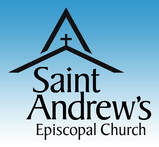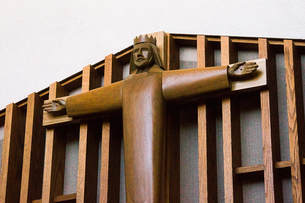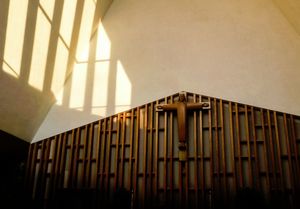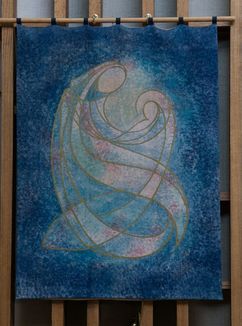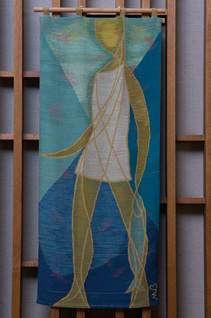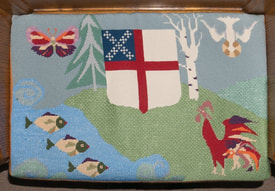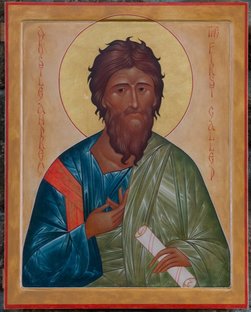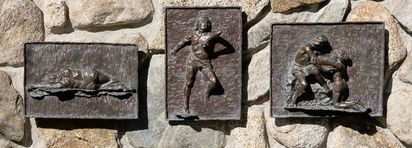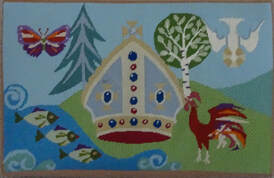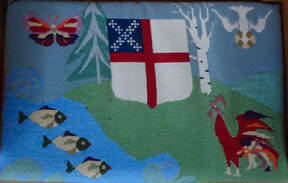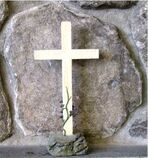Art
|
The large wood sculpture of Christ the King above the free-standing granite altar in the sanctuary was designed by parishioners Albert and Maxine Boyd of Andover and carved by Rodney Woodard of North Conway. It is lighted by the large windows opposite; in the afternoon the mullions cast shadows replicating the woodwork pattern of the reredos.
|
|
Maxine Boyd designed and executed the silk tapestries that hang on the reredos. They depict mother and child on the left, and St. Andrew. the fisherman, on the right. The needlepoint chair cushions and kneelers at the altar rail, shown below, designed by Irene Moore of Hancock, NH, and executed by several parishioners including Betty Scott, Joan Clarke, Nancy Putnam, Izzy Hunter and Gen Madden. |
icon of st. andrew
|
At the back of the sanctuary the St. Andrew in traditional Russian egg tempera iconography was painted by Russian-born the V. Rev’d Andrew Tregubov, pastor at The Holy Resurrection Orthodox Church in Claremont, NH. It was commissioned by Barbara and Ted Brown after a trip to Russia in the late 1990’s and a lecture at St. Andrew’s by Tregubov. He is the author of a book on the iconography of Gregory Kroug who greatly influenced his work. |
relief sculptures in choir and memorial garden
|
In the choir area are angels in relief, made of clay and painted with gold, they represent former parishioner Will Kieffer’s response to the 150th Psalm:
"Praise him with the blast of the ram’s horn; praise him with lyre and harp. Praise him with timbrel and dance; praise him with strings and pipe. Praise him with resounding cymbals . . . " In the Memorial Garden more sculptures by Will Kieffer, high relief bronzes with a brown patina, proclaim the mystery of faith: "Christ has died. Christ is risen. Christ will come again.” |
additional information on the needlepoint kneelers
The kneelers were completed in 196 by women of St. Andrew's Church.
|
1. Three Fish and Shield. The fish, one of the earliest Christian symbols, is derived by using the first letters of Ἰησοῦς Χριστός, Θεοῦ Υἱός, Σωτήρ to spell the Koine Greek word for fish, ΙΧΘΥΣ. Three fish together indicates the Trinity. The shield, an anchor drawn so it forms a cross, over the letter χ (chi), the first letter of Christ in Greek, is another ancient symbol expressing faith and hope through the grace of Jesus Christ.
2. Shield, Butterfly, and Trees. The ρχ (chi, rho) are the first letters of the Greek Χριστός,. The butterfly is a Christian symbol for the resurrection, derived from the three stages of the life: the larval stage the condition of man on earth; the chrysalis the body of man in the death; and the butterfly the resurrected body in eternal life. Three pine trees signify the Trinity boldly represented in the New Hampshire landscape.
3. Shield, Rooster, and Initials. The cross and crown of this shield symbolizes the reward in life after death to those who believe in the crucified Savior: “Be thou faithful unto death and I will give thee the Crown of Life.” (Revelations 2:10). The crown denotes the majesty of God and the cross the way through faith in Christ. The cock crowing is a rebuke to Peter for his lack of steadfastness in faith (Mark 14:72). IHS stand for the Latin Iesus Hominum Salvator – Jesus, Savior of Mankind.
4 and 5. Grapes, Chalice, and Wheat. The chalice is a symbol of Christian faith, the cup of salvation used in the Eucharist. Grapes represent the wine of the Eucharist, the blood of Christ. Wheat represents the bread of communion, the body of Christ. A sheaf of wheat is for bountifulness and thanksgiving.
6 Shield, Birch Trees, and Star. The shield of the Protestant Episcopal Church in the U.S. has the cross of St. George indicating descent from the Church of England with the cross of St. Andrew imposed recalling our indebtedness to the Scottish Episcopal Church. The nine small crosses symbolize the original American dioceses. The birches, in four seasons, are for New Hampshire. The star represent the six days of creation.
|
|
7. Lamb, Dove, and Hand of God. The lamb, a favorite symbol for Jesus (cf. John 1:29). is shown with the cross and banner of victory. The dove, representing the Holy Spirit hovering over the water at creation and above Jesus at his baptism, symbolizes innocence, purity, and peace. The hand is the symbol of God as creator. The three-rayed nimbus on the dove and the hand indicates divinity.
|
9. Seats. These cushions incorporate symbols from the kneelers. The bishop’s seat adds the traditional bishop’s mitre.

